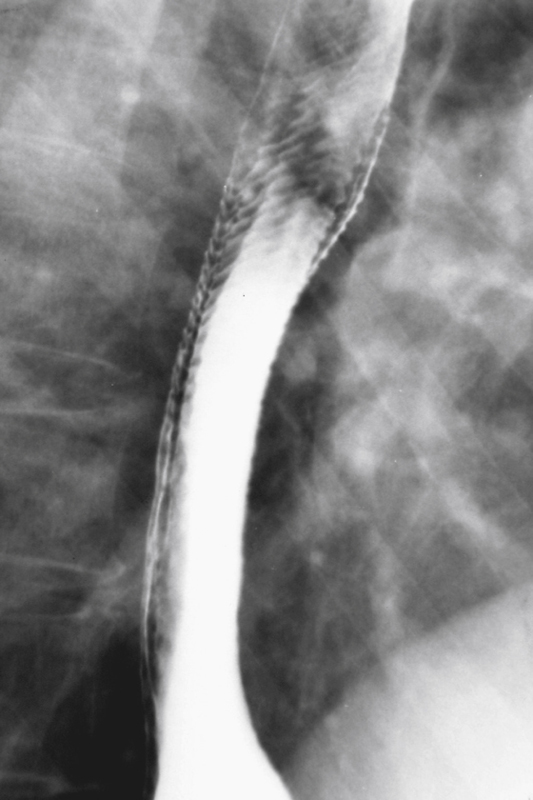CASE 49

History: A 42-year-old man presents with heartburn.
1. Which of the following should be included in the differential diagnosis of the imaging finding shown in the figure? (Choose all that apply.)
E. Thickened folds of esophagitis
2. What is the cause of feline esophagus?
A. Scarring of the longitudinal muscularis mucosa
B. Membranous rings due to hypertrophied muscularis
C. Transient spasm of the longitudinal muscularis mucosa
D. Transient spasm of the circular muscularis mucosa
3. The ringed esophagus, a segment of fixed transverse folds, is a recognized finding in eosinophilic esophagitis. Which of the following statements regarding eosinophilic esophagitis is true?
A. Resolves with antireflux therapy
B. Cancer develops in 10% of patients
C. Dysphagia is the most common presentation
D. Usually associated with eosinophilic gastroenteritis
4. The patient in the figure complains of solid dysphagia, but there is little evidence of stricture or narrowing on the images. What should you do next?
ANSWERS
CASE 49
Feline Esophagus, Eosinophilic Esophagitis
1. B, C, and D
2. C
3. C
4. C
References
Samadi F, Levine MS, Rubesin SE, et al: Feline esophagus and gastroesophageal reflux. Am J Roentgenol. 2010;194:972–976.
Cross-Reference
Gastrointestinal Imaging: THE REQUISITES, 3rd ed, p 31.
Comment
Most of the time the feline pattern of the esophagus (see figure) has been associated with gastroesophageal reflux disease (GERD). It can be seen with or without other findings of GERD, such as ulceration. It does not seem to have any connection to the presence of Barrett’s metaplasia or esophageal carcinoma.
In recent years the condition of eosinophilic esophagitis (EOE) has become widely recognized and discussed in the medical literature. Among the endoscopic and radiographic findings associated with this condition is a corrugated pattern of the esophageal mucosa. This condition, once considered rare, is now being recognized more commonly. It seems to be a disease of Western industrialized nations, of younger patients (aged 20 to 40 years), with solid dysphagia being the most common symptom. The condition (EOE) seems to exist independent of the other eosinophilic infiltrative conditions seen in the stomach and small bowel of atopic patients. There have been no cases of esophageal cancer reported in these patients at this time.







